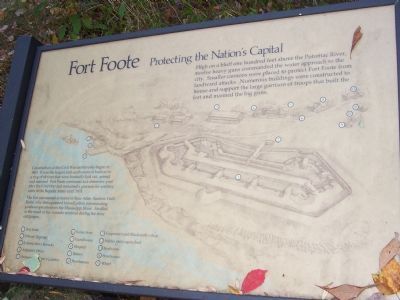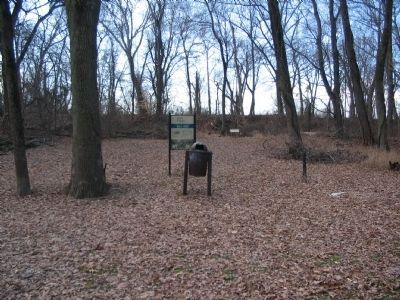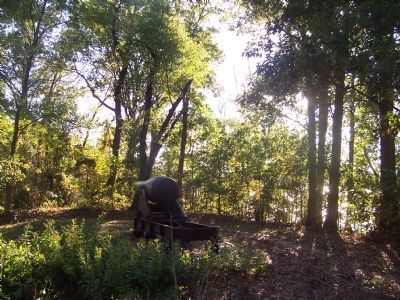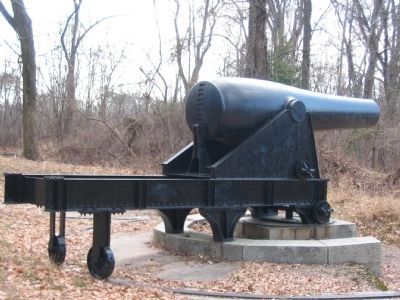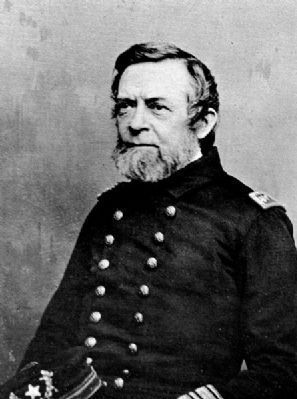Near Fort Washington in Prince George's County, Maryland — The American Northeast (Mid-Atlantic)
Fort Foote
Protecting the Nation’s Capital
Inscription.
High on a bluff, a hundred feet above the Potomac River, twelve heavy guns commanded the approach to the city. Smaller cannon were placed to protect Fort Foote from landward attack. Numerous buildings were constructed to house and support the large garrison of troops that built the fort and manned the big guns.
Construction of this Civil War earthworks began in 1863. It was the largest and southernmost bastion in a ring of 68 forts that were hurriedly laid out, armed and manned. Fort Foote continued as a defensive post after the Civil War and remained a garrison for artillery units of the Regular Army until 1878.
The fort was named in honor of Rear Adm. Andrew Hull Foote, who distinguished himself while commanding gunboat operations on the Mississippi River. He died as a result of wounds received during the river campaigns.
Erected by National Park Service.
Topics and series. This historical marker is listed in these topic lists: Forts and Castles • Military • War, US Civil • Waterways & Vessels. In addition, it is included in the Defenses of Washington series list. A significant historical year for this entry is 1863.
Location. This marker has been replaced by another marker nearby. It was located near 38° 46.071′ N, 77° 1.697′ W. Marker was near Fort Washington, Maryland, in Prince George's County. Marker could be reached from Fort Foote Road. Fort Foote Park is a thickly forested area between Fort Foote Road and the Potomac River. Touch for map. Marker was in this post office area: Fort Washington MD 20744, United States of America. Touch for directions.
Other nearby markers. At least 8 other markers are within walking distance of this location. Another Shot (within shouting distance of this marker); Reporting for Duty (within shouting distance of this marker); Ironclad Killer (within shouting distance of this marker); Engineering Evolution (within shouting distance of this marker); New Forts for a New War (about 300 feet away, measured in a direct line); Load. Ready. Fire! (about 300 feet away); Capital View (about 400 feet away); Welcome To Fort Foote (about 500 feet away). Touch for a list and map of all markers in Fort Washington.
More about this marker. The background of the marker is a drawing of the fort, keyed to a numbered reference list of structures of the fort complex:
1. Fort Foote
2. Officers Quarters
3. Enlisted Men's Barracks
4. Adjutant's Office
5. Ordnance Officer's Quarters
6. Sutler Store
7. Guardhouse
8. Hospital
9. Bakery
10. Storehouses
11. Carpenter's and Blacksmith shop
12. Stables and wagon shed
13. Boathouse
14. Storehouses
15. Wharf
Related marker. Click here for another marker that is related to this marker. New Marker At This Location titled "New Forts for a New War".
Also see . . .
1. Fort Foote Park. National Park Service site detailing the fort. (Submitted on December 12, 2007, by Craig Swain of Leesburg, Virginia.)
2. Civil War Defenses of Washington. National Park Service website entry (Submitted on December 15, 2007, by Richard E. Miller of Oxon Hill, Maryland.)
3. Rear Admiral Andrew Hull Foote. Wikipedia entry (Submitted on March 6, 2011, by Richard E. Miller of Oxon Hill, Maryland.)
Additional commentary.
1. Fort Foote Particulars
From "Mr. Lincoln's Forts: A Guide to the Civil War Defenses of Washington," by Benjamin Franklin Cooling III and Walton H. Owen II:
The perimeter of the fort was 472 yards. Armament as designed was two 15-inch Rodman guns, four 200-pdr Parrott Rifles, and six 30-pdr Parrotts. Eleven additional gun platforms were built, but not used. Over the years, well into the post-Civil War period, the armament was augmented to include 10-inch siege mortars, Gatling Guns, and additional field guns.
The fort was constructed by 2nd Battalion, 9th New York Heavy Artillery, directed
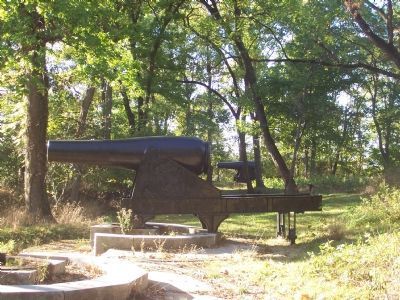
Photographed By Richard E. Miller, October 28, 2007
3. Rodman guns
These 15-inch Rodman guns were left in place when the fort was abandoned in 1878. They lay forgotten and escaped the scrap drives of World War II. In the 1980s the Park Service cleaned up the site and began remounting the guns for display. Of some 322 produced from 1863 to 1871, only 25 exist today. The two here at Fort Foote were produced by the Cyrus Alger Company of Boston, Mass. in 1863-4.
Col. Seward and his wife often entertained guests at the fort, to include President Lincoln and even visiting Russian Naval officers. The massive 15-inch Rodman guns were demonstrated on many occasions, firing their 500-pound solid shot at targets in the middle of the Potomac.
— Submitted December 12, 2007, by Craig Swain of Leesburg, Virginia.
Additional keywords. Defenses of Washington
Credits. This page was last revised on September 30, 2022. It was originally submitted on December 12, 2007, by Richard E. Miller of Oxon Hill, Maryland. This page has been viewed 2,404 times since then and 44 times this year. Last updated on November 30, 2021, by Allen C. Browne of Silver Spring, Maryland. Photos: 1. submitted on December 12, 2007, by Richard E. Miller of Oxon Hill, Maryland. 2. submitted on May 5, 2008, by Craig Swain of Leesburg, Virginia. 3, 4. submitted on December 12, 2007, by Richard E. Miller of Oxon Hill, Maryland. 5. submitted on March 2, 2008, by Craig Swain of Leesburg, Virginia. 6. submitted on March 6, 2011, by Richard E. Miller of Oxon Hill, Maryland. • Bernard Fisher was the editor who published this page.
